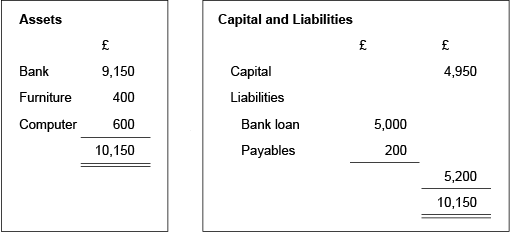4.4 The balance sheet
Returning to our example of Edgar Edwards in Activities 1 and 2, the completed trial balance contains all the elements of the accounting equation.

The accounting equation is the basis of the balance sheet, which shows the total of assets, in this case £10,150 balancing with the total of capital and liabilities £10,150.
Although it may be acceptable to prepare a balance sheet with assets on one side and capital and liabilities on the other (known as the horizontal format) it is more conventional to show assets at the top and capital and liabilities at the bottom (known as the vertical format).
Balance sheets are commonly prepared in a vertical format of the accounting equation. This gives the owners clear information about the assets of the business, the liabilities of the business (the amount it owes) and the capital or owner’s interest in the business. The balance sheet is normally produced at the end of each trading or financial year and is a snapshot of the financial position of the business on the last day of the financial year.

